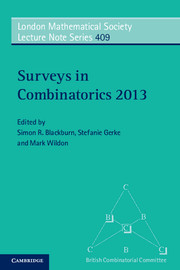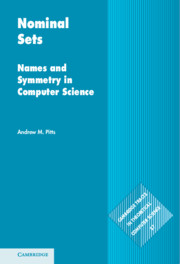Refine search
Actions for selected content:
48287 results in Computer Science
MSC volume 23 issue 4 Cover and Front matter
-
- Journal:
- Mathematical Structures in Computer Science / Volume 23 / Issue 4 / August 2013
- Published online by Cambridge University Press:
- 08 July 2013, pp. f1-f2
-
- Article
-
- You have access
- Export citation

Surveys in Combinatorics 2013
-
- Published online:
- 05 July 2013
- Print publication:
- 27 June 2013

Nominal Sets
- Names and Symmetry in Computer Science
-
- Published online:
- 05 July 2013
- Print publication:
- 30 May 2013
BOLZANO’S CONCEPT OF GROUNDING (ABFOLGE) AGAINST THE BACKGROUND OF NORMAL PROOFS
-
- Journal:
- The Review of Symbolic Logic / Volume 6 / Issue 3 / September 2013
- Published online by Cambridge University Press:
- 03 July 2013, pp. 424-459
- Print publication:
- September 2013
-
- Article
- Export citation
Non-Deterministic Graph Property Testing
-
- Journal:
- Combinatorics, Probability and Computing / Volume 22 / Issue 5 / September 2013
- Published online by Cambridge University Press:
- 03 July 2013, pp. 749-762
-
- Article
-
- You have access
- Export citation
COMMENTS ON “ORDERING PROPERTIES OF ORDER STATISTICS FROM HETEROGENEOUS POPULATIONS”
-
- Journal:
- Probability in the Engineering and Informational Sciences / Volume 27 / Issue 4 / October 2013
- Published online by Cambridge University Press:
- 02 July 2013, pp. 455-462
-
- Article
- Export citation
Analysis of a near-metric TSP approximation algorithm∗
-
- Journal:
- RAIRO - Theoretical Informatics and Applications / Volume 47 / Issue 3 / July 2013
- Published online by Cambridge University Press:
- 06 August 2013, pp. 293-314
- Print publication:
- July 2013
-
- Article
- Export citation
Minimal 2-dominating sets in trees∗
-
- Journal:
- RAIRO - Theoretical Informatics and Applications / Volume 47 / Issue 3 / July 2013
- Published online by Cambridge University Press:
- 08 July 2013, pp. 235-240
- Print publication:
- July 2013
-
- Article
- Export citation
Factoring and testing primes in small space∗
-
- Journal:
- RAIRO - Theoretical Informatics and Applications / Volume 47 / Issue 3 / July 2013
- Published online by Cambridge University Press:
- 30 July 2013, pp. 241-259
- Print publication:
- July 2013
-
- Article
- Export citation
New applications of the wreath product of forest algebras∗
-
- Journal:
- RAIRO - Theoretical Informatics and Applications / Volume 47 / Issue 3 / July 2013
- Published online by Cambridge University Press:
- 30 July 2013, pp. 261-291
- Print publication:
- July 2013
-
- Article
- Export citation
LP+, K3+, FDE+, AND THEIR ‘CLASSICAL COLLAPSE’
-
- Journal:
- The Review of Symbolic Logic / Volume 6 / Issue 4 / December 2013
- Published online by Cambridge University Press:
- 01 July 2013, pp. 742-754
- Print publication:
- December 2013
-
- Article
- Export citation
WHAT CAN A CATEGORICITY THEOREM TELL US?
-
- Journal:
- The Review of Symbolic Logic / Volume 6 / Issue 3 / September 2013
- Published online by Cambridge University Press:
- 01 July 2013, pp. 524-544
- Print publication:
- September 2013
-
- Article
- Export citation
NLE volume 19 issue 3 Cover and Back matter
-
- Journal:
- Natural Language Engineering / Volume 19 / Issue 3 / July 2013
- Published online by Cambridge University Press:
- 28 June 2013, pp. b1-b8
-
- Article
-
- You have access
- Export citation
NLE volume 19 issue 3 Cover and Front matter
-
- Journal:
- Natural Language Engineering / Volume 19 / Issue 3 / July 2013
- Published online by Cambridge University Press:
- 28 June 2013, pp. f1-f2
-
- Article
-
- You have access
- Export citation
9 - Automatic counting of tilings of skinny plane regions
-
-
- Book:
- Surveys in Combinatorics 2013
- Published online:
- 05 July 2013
- Print publication:
- 27 June 2013, pp 363-378
-
- Chapter
- Export citation
4 - The complexity of change
-
-
- Book:
- Surveys in Combinatorics 2013
- Published online:
- 05 July 2013
- Print publication:
- 27 June 2013, pp 127-160
-
- Chapter
- Export citation
Contents
-
- Book:
- Surveys in Combinatorics 2013
- Published online:
- 05 July 2013
- Print publication:
- 27 June 2013, pp v-vi
-
- Chapter
- Export citation
7 - The world of hereditary graph classes viewed through Truemper configurations
-
-
- Book:
- Surveys in Combinatorics 2013
- Published online:
- 05 July 2013
- Print publication:
- 27 June 2013, pp 265-326
-
- Chapter
- Export citation
3 - Bent functions and their connections to combinatorics
-
-
- Book:
- Surveys in Combinatorics 2013
- Published online:
- 05 July 2013
- Print publication:
- 27 June 2013, pp 91-126
-
- Chapter
- Export citation
